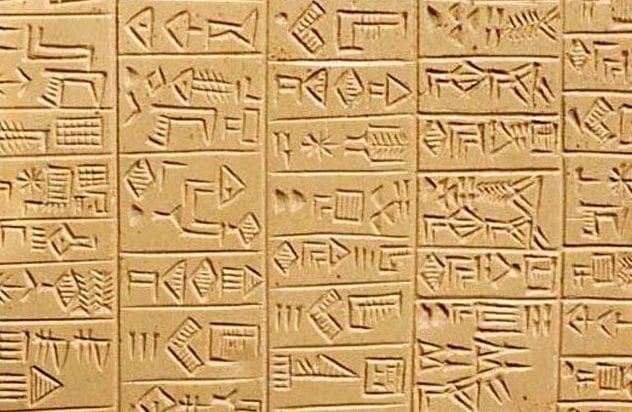 History
History  History
History  Pop Culture
Pop Culture 10 Cases of Grabbing Defeat from the Jaws of Victory
 History
History 10 Common Misconceptions About the Renaissance
 Weird Stuff
Weird Stuff 10 Crazy Things Resulting from Hidden Contract Provisions
 Facts
Facts 10 Unusual Facts About Calories
 Weird Stuff
Weird Stuff 10 Days of Humiliation When the Person Should Have Stayed in Bed
 Humans
Humans 10 Surprising Ways Game Theory Rules Your Daily Life
 Food
Food 10 Popular (and Weird) Ancient Foods
 Animals
Animals Ten Bizarre Creatures from Beneath the Waves
 Technology
Technology 10 Unexpected Things Scientists Made Using DNA
 History
History 10 Events That Unexpectedly Changed American Life
 Pop Culture
Pop Culture 10 Cases of Grabbing Defeat from the Jaws of Victory
 History
History 10 Common Misconceptions About the Renaissance
Who's Behind Listverse?

Jamie Frater
Head Editor
Jamie founded Listverse due to an insatiable desire to share fascinating, obscure, and bizarre facts. He has been a guest speaker on numerous national radio and television stations and is a five time published author.
More About Us Weird Stuff
Weird Stuff 10 Crazy Things Resulting from Hidden Contract Provisions
 Facts
Facts 10 Unusual Facts About Calories
 Weird Stuff
Weird Stuff 10 Days of Humiliation When the Person Should Have Stayed in Bed
 Humans
Humans 10 Surprising Ways Game Theory Rules Your Daily Life
 Food
Food 10 Popular (and Weird) Ancient Foods
 Animals
Animals Ten Bizarre Creatures from Beneath the Waves
 Technology
Technology 10 Unexpected Things Scientists Made Using DNA
10 Ancient Languages With Unknown Origins
Languages can provide us with a great deal of knowledge about a society’s culture, way of life, evolution, and even their migration patterns. They have given us a profound insight into the minds of ancient people, and have enabled us to form the story of humanity’s distance past. However, some discoveries have given us just the exact opposite, and have presented us with the unnerving truth that our past might be shrouded in a mystery we might never solve.
10North Picene

North Picene was a language spoken by the Picentes people living in northeastern Italy during the first millennium BC. The South Picene language has been well-studied, and scholars have identified it as being a distinct Italic language from the Oscan-Umbrian language family. This language differs greatly from South Picene, and linguists have been unable to accurately classify it.
The discovery of North Picene inscriptions were found on a stele near a small town in Italy called Novilara. The language was written in a type of script similar to the Etruscan alphabet, but retained several Greek letters for certain consonants. The grammatical features of the language has stumped scholars, and no collective conclusions can be made from their findings.
9Etruscan

Etruscan was the spoken and written language of the Etruscan civilization, an ancient society that existed in the Tuscany region of Italy before the Roman Empire ever existed. A powerful and sophisticated culture, the Etruscans were the first major civilization in the Western Mediterranean. They are often viewed as a mysterious and unknown society since most of what we know about them comes from accounts written by the ancient Romans.
The language of the Etruscans is often considered a language isolate, unrelated to any other language. There are few languages that share any characteristics with Etruscan in the world. The language is highly inflected, complex, and had many grammatical cases. Little is known about where the language came from, but some linguist propose it is part of the hypothesized group of Tyrrhenian languages.
8Basque

The Basque language is spoken by the Basque people of northern Spain and parts of southwestern France. Although scholars have tried to link Basque to other languages, studies have concluded that it has no known relationship with any other language in the world.
Basque is the only known pre-Roman language to have survived while other Iberian languages have become extinct. Numerous attempts have been made to show a relationship between Basque, Iberian, and Afro-Asiatic languages, but none have been widely accepted. Basque has the unique position of being a living language, giving us a window into understanding the linguistic diversity of ancient people once living on the Iberian peninsula.
7Sumerian

Widely considered the first written tongue, Sumerian was spoken in Mesopotamia during the second millennium BC. The writing system of Sumerian is a script called cuneiform. It is a series of ideograms, symbols, and abstract shapes that represent ideas rather than specific words or sounds. Some cuneiform is deciphered, although many different representations have been established. Linguists and archaeologists still debate over the grammar and syntax of the language, and there’s only about few hundred people in the world with a working knowledge of it.
Similar to other ancient languages, Sumerian is agglutinative. Words can be formed or used with a chain of separate endings and suffixes to convey what is being said. The origins of the language remain unclear, and there is no consistent answer to where it might have come from.
6Ainu

The northern Japanese island of Hokkaido is home to a group of indigenous people called the Ainu, said to be one of the first human inhabitants of the Japanese islands. The Ainu people are a culturally and linguistically different ethnic group from the Japanese people, and are said to be descendants of the Jomon-ji hunter-gathers who migrated to the island around the year 14,500 BC.
An extremely endangered language, Ainu is said to be spoken only by a handful of people. Although the language has no written form to it, it has been traditionally written using Japanese Kana characters. This has made its conservation extremely difficult within the Ainu culture.
5Sicel Language

On the Italian island of Sicily, there was once an ancient tribe of people called the Siculi. One of three indigenous people living on Sicily at the time, the Siculi are said to have been speakers of an Indo-European language, although no concrete conclusion can be made based on the lack of evidence.
The Siculi are said to have possibly come from the areas of Italy known as Liguria or Latium. They had their own distinct culture involving religious cults and the worship of many deities. Eventually, the Siculi were assimilated with Hellenic culture brought to Sicily by the Greeks. Their language was not well written until the introduction of the Greek writing system, and only a handful of inscriptions have survived.
4Vinca

The Vinca language, also named “Old European.” is a hypothetical language proposed from the excavation of symbols found on artifacts in southeast Europe. The symbols are believed to be some of the earliest forms of writing in the world, and might even pre-date Sumerian Cuneiform and the Egyptian hieroglyphics by thousands of years.
The symbols were found in the area occupied by the Vinca people who lived in modern-day western Romania on the banks of the Danube River from about 6000—3000 BC. A mysterious culture, little is known about how they lived and what their society was like. The symbols that represented their language will probably never be deciphered since only short inscriptions were found on a variety of artifacts.
3Hurrian

Hurrian is an ancient extinct language spoken in the area that was once the Hittite Empire. Scholars believe that the speakers of Hurrian originally came from the mountainous areas of Armenia, and had migrated to parts of Mesopotamia and Anatolia during the second millennium BC. Hurrian was once the language of the Mitanni Kingdom before the Assyrian conquest.
Despite it not being classified as related to any other languages, authors Arnaud Fournet and Allan R Bombard published a book describing some distinct characteristics of Indo-European languages in Hurrian.
2Elamite

Elamite was another language spoken in the Mesopotamia region along with Sumerian and Akkadian, isolate. The language is not completely deciphered, although scholars have some understanding of the grammar. It was first written using a primitive script that involved pictograms and logographic symbols, but it was later replaced by Sumerian cuneiform.
An agglutinative language, Elamite shows grammatical elements similar to other ancient languages in spoken in Europe and the Middle East. Complex variations of morphemes and suffixes attached to nouns, verbs, and pronouns were used to convey ideas. Elamite was a SOV language. Verbs were usually placed at the very end of sentences if not followed by other grammatical constructs.
1Raetic

The Raetic language was spoken in the Eastern Alps region of modern-day northern Italy and West Austria. It was the language of the Raeti, a group of indigenous Alpine people around the year 500 BC.
There are several theories in regards to the origins of Raetic. One of them suggests that Raetic, along with Etruscan and Lemnian, are part of the proposed Tyrrhenian language family. Another theory suggests that the language is an independent branch of Indo-European languages. Raetic might also be just a language isolate with Etruscan influences, and we might never know the language’s true origins.
Robert Giametta is a freelance journalist, blogger, and cat-enthusiast millennial living in upstate New York. He spends his spare time drinking copious amounts of tea, reading dystopian novels, and pondering the secrets of the universe.








